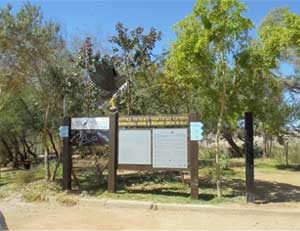
Israel: Sanctuaries in diversity
A desert natural park and a lush bird sanctuary, both existing in a small strip of land that is Israel seemed an unlikely combination. That is, till we were introduced to both- the Mashkesh Ramon Nature Reserve in the Negev desert and the International Birding and Research Center (IBRC) at the mouth of the Red Sea in Eilat.
The contrast in locales in Israel could not have been more prominent than in these two nature parks. Both stand tall in the map of preservation of flora and fauna.
Israel is a country mostly composed of desert land. The innovative drip irrigation system its agricultural scientists have perfected has greened many areas of the country creating man-made oasis where kibbutzes thrive. Kibbutzes, a unique institution of Israel, are community-living centres following a mantra of self –sufficiency and sustainability. In many desert-prone areas as in Rajasthan collaborative efforts using this irrigation technique have shown good results.
To go to the Ramon desert park we started from the small town ofMitzpe Ramon , an hour away from the Dead Sea, the lowest point on earth. Mashkesh Ramon Nature Reserve is Israel’s largest nature park. As expert driver cum guide Gilad Cartoon drove, what looked like an old jalopy, a Land Rover Defender, it seemed we were in for trouble as there was practically no road; it looked more like a moonscape. But both the jeep and the guide proved us wrong.
A makhtesh is unique to the Negev desert. It is a geologicalformation, also seen in Sinai peninsula of Egypt. It has steep walls of resistant rock surrounding a deep closed valley which is usually drained by a single wadi or spring.
The Ramon, the largest natural crater in the world, is 500m deep.Although commonly referred to as ‘craters’, these formations are ‘erosion cirques’ or box canyons. Craters are usually formed by impact of meteors or volcanic eruption.
Mashkesh Ramon is a geologists’ paradise with layers of rock formation in many colours laid out dramatically. Rub a bit of yellow-coloured soft rock, mix a little water, and voila! a sandalwood kind of paste appears.
Millions of years ago, the Negev desert was actually covered by an ocean. The fossil of a sea centipede stuck on a stone we saw vindicated it.
The water body started receding northwards leaving behind a hump-shaped hill. Approximately five million years ago, the Arava Rift Valley, part of the Great Rift Valley that stretches all the way to Africa, was formed by shifting tectonic plates. Rivers changed their courses, chipping away softer rock keeping the hard rock intact. The crater bottom continued to deepen and more layers of ancient rock were exposed; the rocks at the bottom of the crater is estimated to be 200 million years old.
The valley is drained by two rivers Nahal Ramon and Nahal Ardon.Difficult to believe but this arid zone can experience flash floods too, the water going up to the height of hillocks. We were witness to the tell-tale signs of a recent flood; but it also helps to wake up desert plant seeds which lie dormant. The lovely yellow flowers that speckled some patches were witness to nature’s wonderful chemistry.
This area, in fact, was homeland to many Bedouin tribes in the past. It was also on the spice trade route of the Nabataens who built the famed Petra caravan city in Jordan.
Today, the makhtesh is also a field of research into traditional knowledge of the roaming tribes and to showcase how they learnt to use the natural plants for their advantage. Gilad showed a plant that kept away fleas from camels and humans, another which, when rubbed with a bit of water, creates soap-like suds, another that produces a substance like a wheat dough, and aromatic plants that can be used to spice up dishes.

In recent years, some animals have been reintroduced to the eco system mentioned even in ‘biblical’ times. Onager, smallest of the wild horse species which look more like donkeys, is one such. The Ibax , the extremely resilient mountain goat with huge horns, thrive here. We came across a Hyrax, looking like a furry rabbit, but believe it or not, its closest relative is the elephant which used to roam here thousands of years ago.
The lush International Birding and Research Center at the Hula Valley is a completely different terrain. It is near Eilat at the edge of the Red Sea. Eilat is more a resort town. But few know, except enthusiastic birdwatchers and ornithologists perhaps, that for eons this valley has been one of the most important spots for migratory birds in the world. It is the only land bridge between Eurasia and Africa and millions of birds use the salty- marsh land as a resting place and to store food before or after crossing the 3000 km migratory path on the vast Sahara desert in spring and autumn.
Established in the 1990s by the government, IBRC was once an industrial waste site, hard to believe today. Here researchers monitor the birds, ‘ring’ them for the database, sometimes tag them with chips, and then set them free. Noam Weiss, director of the center, a passionate ‘birder’, demonstrated how a bird’s wings can tell its age, how it keeps warm, or cool, and how the tiniest of birds manage to cross the desert.
With a powerful binocular we could see pelicans, flamingoes, ducks and many other species and regretted inwardly how a migration haven like Bharatpur in India has declined while here every effort is made to preserve this ancient migration route, help the birds feed by planting flowering trees they love.
As we novices were ready to leave, after gathering some knowledge at least about bird behaviour, a group of Belgian birdwatchers walked in. There was a flurry of activities too. Weiss informed that an annual competition was due; the winner titled “Champion of Flyaway” is selected for maximum number of bird-species spotting. Many international teams take part. Young students also visit for on-hand experience.
Trans World Features (TWF)
Support Our Journalism
We cannot do without you.. your contribution supports unbiased journalism
IBNS is not driven by any ism- not wokeism, not racism, not skewed secularism, not hyper right-wing or left liberal ideals, nor by any hardline religious beliefs or hyper nationalism. We want to serve you good old objective news, as they are. We do not judge or preach. We let people decide for themselves. We only try to present factual and well-sourced news.






